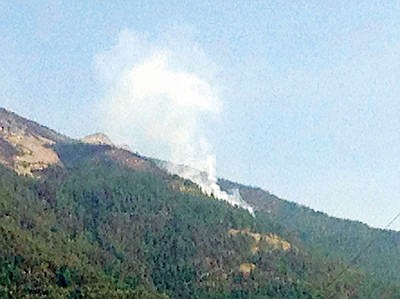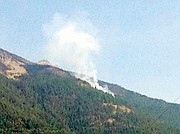Fire management team goes home
The 2015 fire season, while not officially over, is in its final stage. The Type II incident management team assigned to the Goat Rock Complex has officially turned incident command back over to local authorities on the Kootenai National Forest and have demobilized from the fire camp at J. Neils Park in Libby.
The Goat Rock Complex, formalized with the arrival of Chuck Russell’s team Aug. 23, initially included two major fires and several minor ones in the Libby, Cabinet and Three Rivers ranger districts southwest of Libby. It was expanded Sept. 9 to include three additional fires, which were previously being managed by another team as part of the Clark Fork Complex. Responsibility for the fires was officially returned to the Forest Service as of Sept. 14, with a final debriefing and review meeting held at the Kootenai National Forest Supervisor’s Office Sept. 15. In the meeting, team representatives discussed the achievement of all major objectives, although containment of the fires was listed at just 10 percent.
“The strategic objective was point protection due to the potential for large fire growth and proximity to values at risk, which included structures and private properties,” incident commander Chuck Russell wrote in the executive summary of the incident. “Management of the Goat Rock Complex was returned to the delegating authorities on Sept. 14, 2015, at 2000 hours, with 10 percent containment. One hundred percent of our accomplishments were met within our objectives for the complex.”
Due to the nature and location of the fires, the objectives for the team were not to suppress the fires, but to prevent excessive fire growth, protect structures and private property and to prepare a long-term plan for the management of fires within the complex.
At the close-out meeting, the incident management team representatives praised the cooperative relationships they quickly established with local authorities from the Forest Service as well as state and local governments and agencies.
“Fire management is a social challenge,” said deputy incident commander Don Whittemore. “It is about relationships and how everyone aligns and works together. Here we had the Forest Service, the county commissioners, the city and the whole community in alignment. We won the fire assignment lottery coming here.”
All told, 278 personnel were assigned to the Goat Rock incident, along with 50 training assignments. An additional 11 members of Team Rubicon and six Team Rubicon trainees participated in managing the incident. Team Rubicon is a non-profit organization that utilizes military veterans for disaster response. The team members served in security and medical roles, with trainees working in the document unit and as radio operators and public information officers.
The fire affected 24,210 acres at a total cost of $3,859,811. The crews worked a total of 102,000 man-hours without a single reportable accident or injury.
Nationally, the Forest Service has spent nearly a billion dollars on fire suppression efforts this year. The bulk of that money, $700 million, has been transferred from non-fire accounts to cover the unfunded costs this year.
Rocky Mountain team began mobilization: Aug. 21
Team assumed command of incident: Aug. 23
Napoleon, Sawtooth and Government fires transferred from Clark Fork Complex: Sept. 9
Responsibility transferred to Kootenai National Forest: Sept. 14
Containment level at demobilization point: 10 percent
Total acreage involved: 24,210
Aircraft cost: $356,324
Crew cost: $461,788
Line personnel cost: $264,428
Equipment cost: $1,107,221
Camp personnel cost: $696,908
Camp support cost: $973,142
Total cost of incident: $3,859,811



